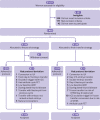Freeze-all versus fresh blastocyst transfer strategy during in vitro fertilisation in women with regular menstrual cycles: multicentre randomised controlled trial
- PMID: 32759285
- PMCID: PMC7399608
- DOI: 10.1136/bmj.m2519
Freeze-all versus fresh blastocyst transfer strategy during in vitro fertilisation in women with regular menstrual cycles: multicentre randomised controlled trial
Abstract
Objective: To compare the ongoing pregnancy rate between a freeze-all strategy and a fresh transfer strategy in assisted reproductive technology treatment.
Design: Multicentre, randomised controlled superiority trial.
Setting: Outpatient fertility clinics at eight public hospitals in Denmark, Sweden, and Spain.
Participants: 460 women aged 18-39 years with regular menstrual cycles starting their first, second, or third treatment cycle of in vitro fertilisation or intracytoplasmic sperm injection.
Interventions: Women were randomised at baseline on cycle day 2 or 3 to one of two treatment groups: the freeze-all group (elective freezing of all embryos) who received gonadotropin releasing hormone agonist triggering and single frozen-thawed blastocyst transfer in a subsequent modified natural cycle; or the fresh transfer group who received human chorionic gonadotropin triggering and single blastocyst transfer in the fresh cycle. Women in the fresh transfer group with more than 18 follicles larger than 11 mm on the day of triggering had elective freezing of all embryos and postponement of transfer as a safety measure.
Main outcome measures: The primary outcome was the ongoing pregnancy rate defined as a detectable fetal heart beat after eight weeks of gestation. Secondary outcomes were live birth rate, positive human chorionic gonadotropin rate, time to pregnancy, and pregnancy related, obstetric, and neonatal complications. The primary analysis was performed according to the intention-to-treat principle.
Results: Ongoing pregnancy rate did not differ significantly between the freeze-all and fresh transfer groups (27.8% (62/223) v 29.6% (68/230); risk ratio 0.98, 95% confidence interval 0.87 to 1.10, P=0.76). Additionally, no significant difference was found in the live birth rate (27.4% (61/223) for the freeze-all group and 28.7% (66/230) for the fresh transfer group; risk ratio 0.98, 95% confidence interval 0.87 to 1.10, P=0.83). No significant differences between groups were observed for positive human chorionic gonadotropin rate or pregnancy loss, and none of the women had severe ovarian hyperstimulation syndrome; only one hospital admission related to this condition occurred in the fresh transfer group. The risks of pregnancy related, obstetric, and neonatal complications did not differ between the two groups except for a higher mean birth weight after frozen blastocyst transfer and an increased risk of prematurity after fresh blastocyst transfer. Time to pregnancy was longer in the freeze-all group.
Conclusions: In women with regular menstrual cycles, a freeze-all strategy with gonadotropin releasing hormone agonist triggering for final oocyte maturation did not result in higher ongoing pregnancy and live birth rates than a fresh transfer strategy. The findings warrant caution in the indiscriminate application of a freeze-all strategy when no apparent risk of ovarian hyperstimulation syndrome is present.
Trial registration: Clinicaltrials.gov NCT02746562.
© Author(s) (or their employer(s)) 2019. Re-use permitted under CC BY-NC. No commercial re-use. See rights and permissions. Published by BMJ.
Conflict of interest statement
Competing interests: All authors have completed the ICMJE uniform disclosure form at www.icmje.org/coi_disclosure.pdf and declare: support from the Reprounion collaborative study, cofinanced by the European Union, Interreg V ÖKS for the submitted work; PH has received grants and personal fees from Merck, Gedeon Richter, and IBSA, and grants from MSD and Ferring outside the submitted work; NPP reports grants and personal fees from MSD, Merck Serono, Ferring, Theramex, and BESINS International, and personal fees from IBSA and Gedeon Richter outside the submitted work; ANA reports personal fees from Merck and Ferring, and grants from Roche Diagnostics, outside the submitted work; no other relationships or activities that could appear to have influenced the submitted work. All other authors declare no competing interests.
Figures
References
-
- De Geyter C, Calhaz-Jorge C, Kupka MS, et al. European IVF-monitoring Consortium (EIM) for the European Society of Human Reproduction and Embryology (ESHRE) ART in Europe, 2014: results generated from European registries by ESHRE: The European IVF-monitoring Consortium (EIM) for the European Society of Human Reproduction and Embryology (ESHRE). Hum Reprod 2018;33:1586-601. 10.1093/humrep/dey242. - DOI - PubMed
-
- Kolibianakis E, Bourgain C, Albano C, et al. Effect of ovarian stimulation with recombinant follicle-stimulating hormone, gonadotropin releasing hormone antagonists, and human chorionic gonadotropin on endometrial maturation on the day of oocyte pick-up. Fertil Steril 2002;78:1025-9. 10.1016/S0015-0282(02)03323-X - DOI - PubMed
-
- Shapiro BS, Daneshmand ST, Garner FC, Aguirre M, Hudson C, Thomas S. Evidence of impaired endometrial receptivity after ovarian stimulation for in vitro fertilization: a prospective randomized trial comparing fresh and frozen-thawed embryo transfers in high responders. Fertil Steril 2011;96:516-8. 10.1016/j.fertnstert.2011.02.059. - DOI - PubMed
Publication types
MeSH terms
Substances
Associated data
LinkOut - more resources
Full Text Sources
Medical

